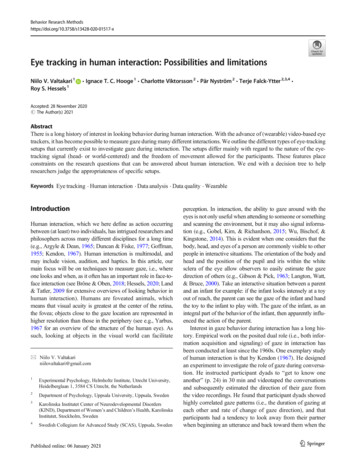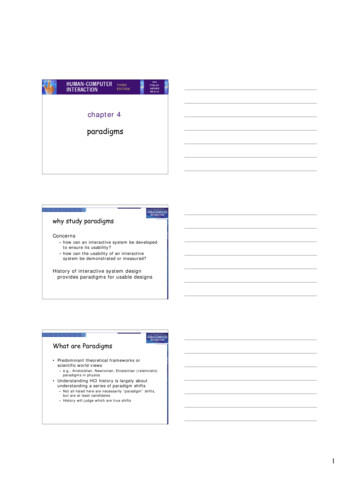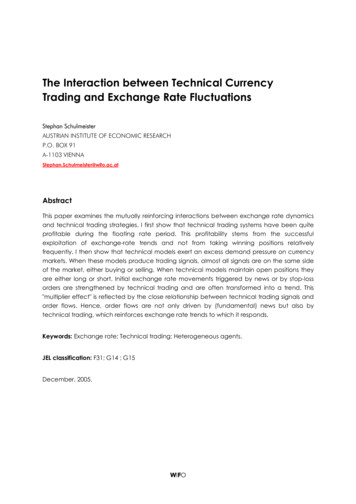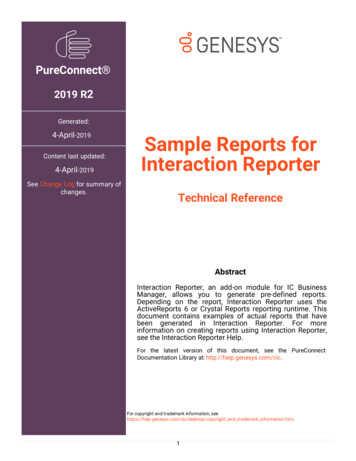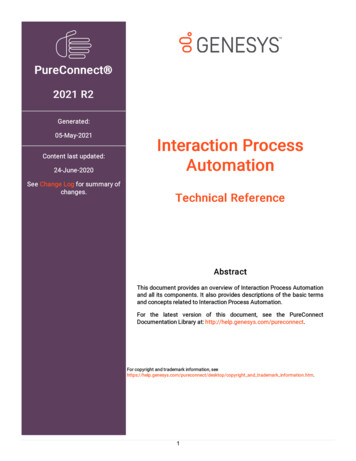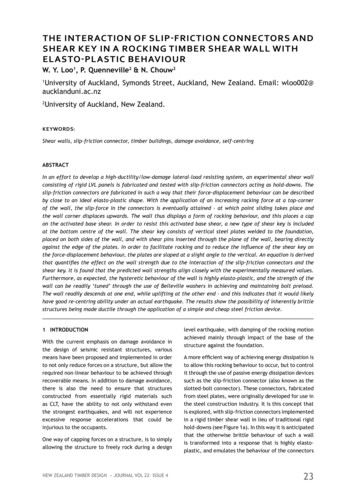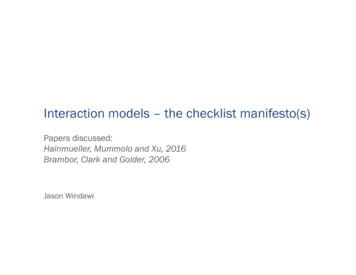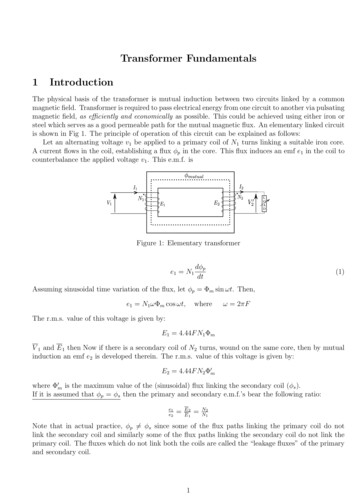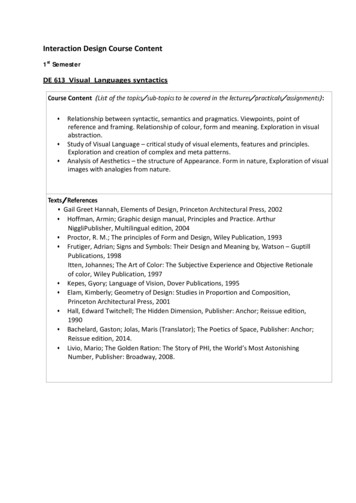
Transcription
Interaction Design Course Content1st SemesterDE 613 Visual Languages syntacticsCourse Content (List of the topics/sub-topics to be covered in the lectures/practicals/assignments): Relationship between syntactic, semantics and pragmatics. Viewpoints, point ofreference and framing. Relationship of colour, form and meaning. Exploration in visualabstraction.Study of Visual Language – critical study of visual elements, features and principles.Exploration and creation of complex and meta patterns.Analysis of Aesthetics – the structure of Appearance. Form in nature, Exploration of visualimages with analogies from nature.Texts/References Gail Greet Hannah, Elements of Design, Princeton Architectural Press, 2002 Hoffman, Armin; Graphic design manual, Principles and Practice. ArthurNiggliPublisher, Multilingual edition, 2004 Proctor, R. M.; The principles of Form and Design, Wiley Publication, 1993 Frutiger, Adrian; Signs and Symbols: Their Design and Meaning by, Watson – GuptillPublications, 1998Itten, Johannes; The Art of Color: The Subjective Experience and Objective Retionaleof color, Wiley Publication, 1997 Kepes, Gyory; Language of Vision, Dover Publications, 1995 Elam, Kimberly; Geometry of Design: Studies in Proportion and Composition,Princeton Architectural Press, 2001 Hall, Edward Twitchell; The Hidden Dimension, Publisher: Anchor; Reissue edition,1990 Bachelard, Gaston; Jolas, Maris (Translator); The Poetics of Space, Publisher: Anchor;Reissue edition, 2014. Livio, Mario; The Golden Ration: The Story of PHI, the World’s Most AstonishingNumber, Publisher: Broadway, 2008.
DE 627 Indian thought and traditionCourse Content (List of the topics/sub-topics to be covered in the lectures/practicals/assignments):This is an exposure course to Indian thought and traditions which will cover various domains likeIndian visual art, oral traditions, music, dance, theatre, science, health and architecture andsociety that make India stand out uniquely as a nation because of its diversity of cultures,languages, religions and customsVisual Art – Traditional and contemporary schools of Indian Art, folk artOral Traditions from the ancient to the presentMusic – Classical (Hindustani & Carnatic) Semi- classical, Folk, FusionDance – Classical, Folk, ContemporaryTheatre – Traditional (Natyashastra), Contemporary, Puppet TheatreScience – An understanding of the scientific approach to everything and the holistic approach toit and how it influenced all aspects like health, architecture, management and even the arts.Post independence understanding of India as a nation and bridging the wealth of the past withthe potential of the future.Reflection of this exposure to the question – What is or what can be called ‘Indian’ Design.Texts/References IyerBharatha K., Indian Art- a Short Introduction, Taraporwala 1982.Gandhi Indira, Eternal India, BI Publications 1980.Boner, Sharma Baumer; Vastusutra Upanishad, MotilalBanarasidas, 1982.DE 629 Introduction To PhotographyCourse Content (List of the topics/sub-topics to be covered in the lectures/ practicals /assignments):Lens, Focal Length, Exposure (Shutter speed, Aperture, ISO), Depth of Field, Histogram, PictureStyles, RAW image, Digital Imaging, Sensor, Crop Factor, Light Metering (Incident, Reflected),Photographic Documentation.
Texts/References Andrews, Philip & Langford, Michael, Langford's Starting Photography: The Guide toCreating Great Images, Focal Press, 2008.Hirsch, Robert, Light and Lens: Photography in the Digital Age, Taylor & FrancisGroup, 2012.Page, David A. &Zakia, Richard D., Photographic Composition: A Visual Guide, FocalPress, 2011Hunter, Fil&Biver, Steven & Fuqua, Paul, Light Science and Magic : An Introduction tophotographic Lighting, Focus Press, 2012.Zakia, Richard D., Perception and Imaging: Photography—A Way of Seeing, FocalPress, March 2013.Berger, John, Ways of Seeing, Penguin, 25 Sep 2008.Arnheim, Rudolf, Visual Thinking, University of California Press, April 16, 2004.DE 631 Introduction to TypographyCourse Content(List of the l’s/assignments):History of Typography, Type Terminology, Font Classification, Anatomy of Typefaces,Introduction to Indic Script Typography, Typesetting, Web Typography.Texts/References Ruegg, Ruedi&Frohlich, Godi : Basic Typography, ABC edition, Zurich,1972.Naik, Bapurao; Typography of Devanagari. Directorate of Languages, Bombay, 1971.Ruder, Emil; Typography, a manual of Design March 1, 2001.Schmid, Helmut: The Road to Basel, 1997.Bringhurst, Robert; The elements of typographic Styl. Hartley and Marks15 Jan 2013.Elam, Kimberly; Exprssive Typography. The word as image, 1990.Bain, E.K; Display Typography, 1970.McLean, Ruari; Manual of typography. Thames and Hudson, 1980.Lupton, Ellen; Thinking with type : a critical guide for designers, writers, editors, andstudents, New York : Princeton Architectural Press 2004.Schmid, Helmut; The road to Basel, Helmut SchmidDesign, 1997.Samara, Timothy; Making and breaking the grid: a graphic design layout workshop.Gloucester : Rockport Pub, 2005.Jute, Andre; Grids: the structure of graphic design.Crans-Pres-Celigny: Rotovision,2002.Muller-Brockmann, Josef; Grid systems in graphic design. Arthur Niggli, Netherlands,2010.
DE 633 Colour, Composition and LayoutCourse Content (List of the topics/sub-topics to be covered in the lectures/practicals/assignments): Colour Theory, Colour through different mediums, Physical properties of Colour, ColourSchemes, Colour Harmonies, Colour Symbolism.Methods of Composition: Realistic, Decorative, Abstract Compositions etc. Principles ofOrganization & Composition: Repetition, Variety, Contrast, Radiation, Rhythm, Balance,Gradation, Dominance & Subordination, Transition, Harmony, Unity etc.Texts/References Interaction of Color: Revised and Expanded Edition by Josef Albers,28-Jun-2013Itten, Johannes; The Art of Color: The Subjective Experience and Objective Rationaleof Color, Wiley Publications, 1997.Color: A Natural History of the Palette by Victoria Finlay, 2007.Edwards, Betty; New Drawing on the Right Side of the Brain, Publisher: Tarcher, 2012.Visual Language for Designers: Principles for Creating Graphics that PeopleUnderstand by Connie Malamed, 2011.Universal Principles of Design by William Lidwell, 2010.Visual Grammar by Christian Leborg, 2006.Design Basics by David A. Lauer, Harcourt College Pub; 4th edition (1994-09-01)(1656)DE 635 Interface DesignCourseContent(List ofthe ls/assignments): Human capabilities (e.g., visual and auditory perception, memory, mental models,and interface metaphors)Interface technology (e.g., input and output devices, interaction styles, andcommon interface paradigms)Interface design methods (e.g., user-centered design, prototyping, and design principlesand rules), and interface evaluation (e.g., software logging, user observation,benchmarks and experiments)Interaction principles, requirements analysis, designing for different screens (web, TVs andmobile devices), design standards, style guides, techniques and visual design principles.
Texts/References Cooper, Alan. The Inmates Are Running the Asylum: Why High Tech Products DriveUs Crazy and How To Restore The Sanity. USA: Sams01-Jan-1999.Garrett, Jesse James. The Elements of User Experience: User Experience: User- Centered Design for the Web. USA: New Riders Press, 2002.Heskett, John. Toothpicks and Logos: Design in Everyday Life. UK: Oxford UniversityPress, 2003.Krug, Steve. Don’t Make Me Think: A Common Sense Approach to Web Usability.USA: Basic Books, 2000.Norman, Donald. Emotional Design: Why We Love (Or Hte) Everyday Things. USA:Basic Books, 2003.Norman, Donald. Things That Mke Us Smart: Defending Human Attributed in the Ageof the Machine, USA: Addison Wesley Publishing Company, 2014.Norman, Donald. The Design of Everyday Things. USA: Basic Books, 2013.Papanek, Victor. Design for the Real World: Human Ecology and Social Change. USA:Academy Chicago Publishers, 2003.Preece, Jennifer et al. Interaction Design. USA: John Wiley & Sons07-Jun-2011.Raskin, Jef. The Humane Interface : New Directions for Designing Interactive Systems.USA: Addison-Wesley Professional, 2000. DE 637 User studiesCourse Content (List of the topics/sub-topics to be covered in the lectures/practicals/assignments): Gathering user data through observation and contextual interviewsInterpreting interviews with team members, creating work models (Flow,sequence, culture, physical, artefact etc.)Consolidating data across users with techniques such as affinity diagrams and personasUsing data in the design processComparison of contextual interview to other techniques such as survey research,focus groups, Rapid Assessment Procedure, task analysis.Texts/References Beebe, James; Rapid Assessment Process; Rowman& Littlefield (2001)Beyer, Hugh; Holtzblatt, Karen; Contextual Design: Defining Customer CenteredSystems; Morgan Kaufmann (1997)Hackos, JoAnn T; Redish, Janice C., User and Task Analysis for Interface Design; Wile(1998).Handwerker, W. Penn; Quick Ethnography; Altamira Press (2001)Mike Kuniavsky; Observing the User Experience, Morgan Kaufmann (2012)Wendell J, Holtzblatt K, Wood S, Rapid Contextual Design, Morgan Kaufmann (2004)
DE 639 Usability EvaluationCourse Content (List of the topics/sub-topics to be covered in the lectures/practicals/assignments): Elements of user experiencePrinciples, heuristics, patterns, guidelines and standards of human-computer interactionSetting user experience goals for a productHeuristic evaluationUsability evaluation, think aloud protocol, card sorts and user performance testsRecruitment and design of usability testsIntroduction to quantitative evaluation techniques.Texts/References Jesse James Garrett, The Elements of User Experience, New Riders (2010)Dix, Alan J.; Finlay, Janet E.; Abowd, Gregory D.; Beale, Russell; Human-ComputerInteraction, Pearson Education; 2008.Dumas, Joseph S.; Redish, Janice C.; Practical Guide to Usability Testing; Exeter : Intellect(1999)Nielson, Jackob; Usability Engineering; Morgan Kaufmann (2015)Mike Kuniavsky; Observing the User Experience, Morgan Kaufmann (2012)Tom Tullis, Bill Albert, Measuring the User Experience, Morgan, 2013.DE 641 Interactions, Media, SensesCourse Content (List of the topics/sub-topics to be covered in the lectures/practicals/assignments): Designing interactions for the Physical, Cognitive and Social environments of the userDigital Smart Medias and co-evolution of technology- Understanding design in the contextof digital, Smart products with information, databases, connectivity, sensors andmultimodal displays.Study of how people sense, perceive, understand, use and experience interactive objectsand spaces.
Texts/References Bonsiepe, Gui; Interface: an approach to design; edited by Dawn Barrett; Maastricht: Janvan Eyck Akademie (1999)McKim, Robert; Experiences in Visual Thinking, Publisher: Brooks/Cole PublishingCompany, 1980Buxton, Bill; Sketching User Experiences: Getting the Design Right and the Right Design(Interactive Technologies), Morgan Kaufmann, 2010Ackerman, Diane; A Natural History of the Senses, Vintage, ISBN 0679735666,1990Wurman, Richard Saul; Information Architects, Watson-Guptill Publications, 1997Cooper, Alan; Reimann, Robert; About Face 2.0 the Essentials of Interaction Design;Wiley (2003)Dix, Alan J.; Finlay, Janet E.; Abowd, Gregory D.; Beale, Russell; Human-ComputerInteraction, Pearson Education; 2 edition (1998)Galitz, Wilbert O.; The Essential Guide to User Interface Design; Wiley; 2 edition (2002)Garrett, Jesse James; The Elements of User Experience; New Riders (2010)Gershenfeld, Neil; When Things Start to Think; New York: Henry Holt (1999)Mandel, Theo; The Elements of User Interface Design; Wiley; (1997)Norman, Donald A.; The Design of Everyday Things; Basic Books; 1988 (2013)Preece, Jenny; Rogers, Yvonne; Sharp, Helen; Interaction Design: Beyond HumanComputer Interaction; John Wiley & Sons, Inc. (2015)Surowiecki, James; The Wisdom of Crowds, Little, Brown (2005)Moggridge, Bill; Designing for Interactions, MIT Press, (2007)DE 663 Sketching 1Course Content (List of the topics/sub-topics to be covered in the lectures/practicals/assignments): Exercises on lines, curves to improve the hand mind coordination.1, 2 and 3 point perspectives. Theory and examples from nature.Drawing of objects from outdoor.Exercises for improving observation and visual memory.
Texts/References Edwards, Betty; New Drawing on the Right Side of the Brain, Publisher: Tarcher; 2002Powell, Dick; Design Rendering Techniques: A Guide to Drawing and PresentingDesign Ideas, Publisher: North Light Books, 1996Caplin, Steve; Banks, Adam; The Complete Guide to Digital Illustration, Publisher:Watson - Guptill Publications, 2003.Demers, Owen; Digital Texturing &Paintin, Publisher: New Riders Press; Bk & CDRom edition 2001.Pogany, Willy; The Art of Drawing, Publisher: Madison Books, 1996McKim, Ribert; Experiences in Visual Thinking, Publisher: Brooks/ Cole PublishingCompany, 1980.2nd SemesterDE 612 Design IssuesCourse Content (List of the topics/sub-topics to be covered in the lectures/practicals/assignments): This course will contain two predominant approaches. The first is reflective which will helpstudents to ponder on the very basic yet subjective questions like what makes a gooddesigner.It will address understanding perceptions & Paradigms which enable students to“think outside the box” by identifying the boxes one creates inadvertently whiledesigning.It will deal with the tangible and intangible relevance of broadening one’s perspectives inArts Aesthetics, Science and Technology to design.The second is an exposure to different thoughts and perspectives, concerns and issues inthe context of design.The challenges in design, layers or user experience,
Samara, Timothy; Making and breaking the grid: a graphic design layout workshop. Gloucester : Rockport Pub, 2005. Jute, Andre; Grids: the structure of graphic design.Crans-Pres-Celigny: Rotovision, 2002. Muller-Brockmann, Josef; Grid systems in graphic design. Arthur Niggli, Netherlands, 2010. DE 633 Colour, Composition and Layout Course Content (List of the topics/sub


